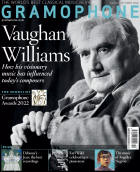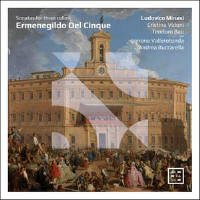Texte paru dans: / Appeared in: |
|
|
Outil de traduction |
|
|
How could it have been that, before this treat of a recording landed on my desk, I didn’t know that the most prolific cello composer of all time was Ermenegildo Del Cinque (1700-73)? Moreover, that I had never even heard of him? Still, I take a small crumb of comfort from the fact that he doesn’t get a mention in the weighty dictionary of music on my shelf either, and also that this appears to be the only available recording of any of his music. Del Cinque was a priest, nobleman, poet, painter and renowned virtuoso cellist from Rome who wrote over 100 sonatas for two cellos and 18 pieces for three cellos. He also composed cantatas, a serenata and some sacred music. And to thank for unearthing his music we have Il Pomo d’Oro’s principal cellist Ludovico Minasi, who in turn has gathered together harpsichordist-conductor Andrea Buccarella and viola da gamba player Teodoro Baù, lutenist Simone Vallerotonda and cellist Cristina Vidoni. Also worth drawing your attention to is that the album title doesn’t quite do justice to Minasi’s attractively diverse choice of works, because sprinkled between six of the three-cello sonatas are also two of the twocello sonatas. It’s also a nice touch that the recording venue is in the Roman palazzo of Duke Giovanni Antonio Altemps, where Del Cinque himself performed. Stylistically this is a language falling under the late Baroque banner rather than the emerging stile galante. Structurally, meanwhile, we’re in four-movement territory, mostly through-composed, and avoiding dance forms. Indeed, think church sonatas – perhaps appropriately, given Del Cinque’s status as a man of the cloth. Minasi and colleagues more than make the case for Del Cinque’s rehabilitation. Playing both overhand and underhand, the cellists blend beautifully with each other. It’s all immensely elegantly shaped and dispatched, simultaneously understated and brimming with different shapes and shades of tone colouring and articulation. Sonata No 5 in D for three cellos has quickly emerged as a personal favourite: an exquisitely rendered unaccompanied Adagio first movement; a neatly nimble Vivace vibrato (an interesting movement title, incorporating both tempo and timbre), danced out to Vallerotonda’s merrily strumming guitar; another warmly loving unaccompanied slow movement; then the triple-time swing of the concluding Allegretto moderato, the cellists now complemented by the return of Vallerotonda’s guitar and Buccarella on harpsichord. Or, to sample the delicately detailed phrasing, hop to the end of threecello Sonata No 17 in G minor’s concluding Lento e amoroso for the sudden dynamically contrasting call and response sequence between Minasi and the other two. All this is recorded with a sophisticated balance, cellos immediate but not too close, while plucked instruments are largely kept well back, lending a suavely sympathetic background sprinkle of texture and colour. Have I persuaded you to give it a spin? I do hope so.
|
|




